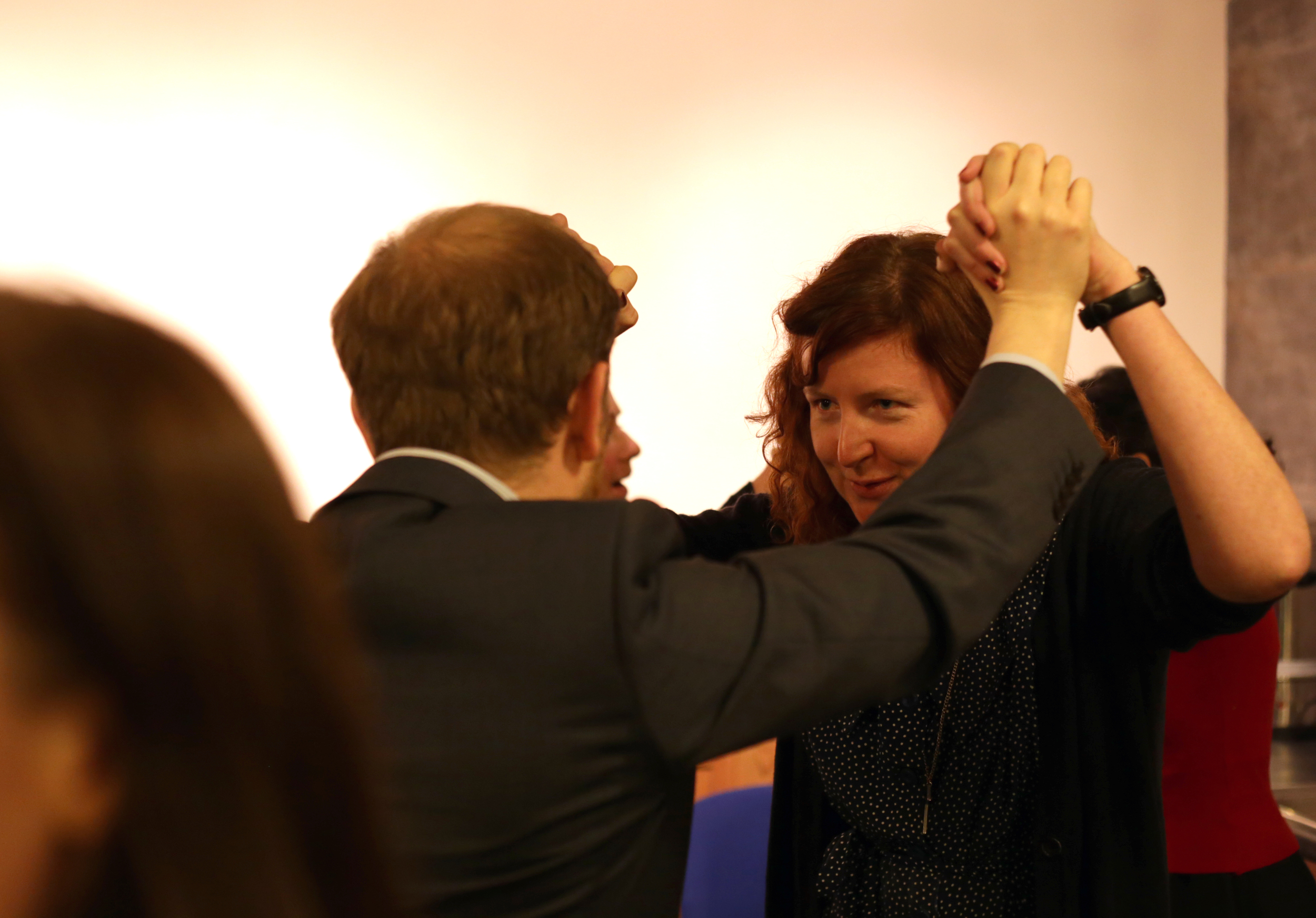"Be precise." That was my dad's favourite phrase when I was growing up. Though infuriating at the time, it's proved to be sound advice. No one ever died from too much clarity, but lots of us have suffered the lack of it. Whether you're leading a team, collaborating with colleagues or negotiating social relationships, clarity makes everything so much easier.
Don't be a hermit – interact with impact with these five tips
Human interaction is at the heart of work. Its impact is everywhere – from process to productivity, outcome and enjoyment. Unless, of course, you’re a hermit.
Despite its centrality, that interaction can often feel unpredictable, ineffective and draining. After all, you can never guarantee someone else’s behaviour. You can, however, ensure your own is more influential, clear and effective.
Below are five tools to help you make the impact you choose in your daily interactions. Yes, they take practice, but they can make a crucial difference – particularly if you’re leading change. Either way, they’ll help you achieve your outcomes without wasting time and energy. No need to become a hermit, then.
1. Don’t look down!
Look up, make eye contact, then begin. Taking that moment to connect tells people you're fully present – and that your contribution is worth their attention. This is particularly useful in presentations and when opening meetings. Good eye contact also signals that you’re engaged with their response.
It might sound obvious, but it’s surprising how many of us launch straight in, without first establishing a connection. In so doing we risk throwing away our words on a distracted audience, silently dismissing their contribution, and reducing our impact.
2. Stand your ground
Yep, even if you’re seated. If you’re standing, keep your feet hip-width apart. Feel the ground through your feet. Resist the urge to drop one hip or place your weight on one leg. Again, obvious enough, but not always easy to avoid in the moment. If you’re sitting, feel the ground evenly through both feet. It can be tricky in a skirt, but worth doing whenever possible.
Feeling the ground through your feet does what it says on the tin; it helps you feel more grounded and present. It also stabilises your posture, preventing you either feeling or looking like you’re in 'fight or flight'. And that in turn creates a more powerful presence.
3. Abdominal breathing
Imagine a pair of bellows. As the air goes in, they expand; as it leaves, they contract. The same idea applies to abdominal breathing, ideally through a slightly open mouth. As you breathe into the bottom of the lungs the abdomen expands; as you breathe out it contracts. The most important thing, however, is to breathe out first!
Breathing is critical both to how you feel we’re perceived and how you are perceived – influencing how you behave and others respond. Most people take shallow breaths and/or hold their breath, particularly when nervous or challenged. Abdominal breathing reverses this so you operate more effectively. It also helps you speak more clearly and avoid swallowing words. You’ll feel better, be perceived more positively, and imbue your words with the impact you intend.
4. Take the space
Being aware of the space around you – above, below, in front and behind – can transform the impact of your presence. Unfold into that space. Release your arms from your sides. Broaden your shoulders away from your ears. And keep your feet hip-width apart. Hunched shoulders, crossed arms and a caved chest don’t just restrict breathing and create tension. They also make you physically smaller – impacting on your personal presence and suggesting that you don't want to be there.
So take the space, expand into it, occupy it. Your posture will improve. Your chest will open and you'll breathe more easily. You’ll create a stronger presence. And you'll signal to others that you are ready to be seen and to engage.
5. Channel your inner ventriloquist
Okay, not really – but imagining that the stomach (venter) is powering your speech (loqui) can help you project without straining or shouting.
Most people reach forward with their head and neck when they want to be heard. Bring them back instead so they’re aligned with your spine. Relax the throat – it will tense if you shout – and, when you speak, engage your lower abdominals. Projection can take some practice, and works best in conjunction with the other tools. Once cracked, however, you'll deliver your ideas with impact. It's also brilliant sore throat prevention in noisy pubs!
Want to learn more? Download our free Chirp Guide to find out how to use your voice more effectively in meetings, pitches and presentations.
Why singing is for life, and not just for Christmas
As December settles in, some of you will already have had your fill of seasonal songs. If you work in retail, or have just left the house lately, chances are you’ll have encountered The Christmas Soundtrack.
Loved or loathed, festive refrains are almost inescapable this month – and not only the recorded variety. It’s a funny thing, but this time of year seems to coax even avowed naysayers to burst into song. (The flow of Christmas spirit(s) may help.)
Perhaps these winter warblers grasp instinctively that singing connects and unites, even if they’re not sure why. It’s certainly effective, and at the heart of Chirp.
As we’ve developed our work with leaders and organisations, we’ve examined why singing is so powerful. Below, we share three key reasons to dust down your vocal chords – and not just at Christmas.
Risk and exposure
Singing, particularly with colleagues, can be a touch unnerving. It requires us to step away from comfort zones, experience challenge, and feel a bit exposed. That exposure can be valuable, eliciting honest, engaged, and insightful discussion of personal responses and group dynamics.
Trust and connection
Singing develops trust, intensified by mutual reliance. Harmony is contingent on each individual fulfilling his or her role, and taking personal as well as collective responsibility for the team’s success. Singing together behoves each person to listen, support, respond and adapt in the moment so that everyone thrives.
Change and uncertainty
Singing unfolds in real time. The outcome is uncertain yet exciting, and not entirely within our control. Singing develops our capacity to acknowledge uncertainty while remaining focused and engaged – a critical skill in our rapidly changing world. How we manage that uncertainty in singing is often a useful insight into how we experience challenge, ambiguity and change at work.
We hope you enjoy a jolly good seasonal sing – with colleagues, friends and family, or even strangers. Drop us a line if you’d like to learn more about how and why we use singing to create skilled, dynamic colleagues all year round. After all, singing is for life, not just for Christmas!
What lies beneath? Get your brain scanned and find out!
'B0005622 Enhanced MRI scan of the head' by Mark Lythgoe & Chloe Hutton / Wellcome Images, licenced under CC BY-NC-ND 2.0
We're hugely excited to be working with neuroscientists at University College London (UCL) and Ashridge Business School to investigate the science behind singing. The UCL pilot will be one of the first in an emerging field that explores why social interaction is so important to health and well-being. And the Ashridge research will valuably contribute to our understanding of both resilience and learning. Both have potentially exciting applications in the workplace, education and health.
We're recruiting potential participants now while we nervously await the outcome of our funding bids. So, if you've ever fancied finding out what's really going on inside, now's your chance! We're looking for participants of all backgrounds, and particularly scientists.
UCL RESEARCH
Using fRMI scanners, we'll look at what happens in the brain when you sing, how it differs from speech, and why many people find that singing together creates social bonds.
We're looking for 30 adults who:
consider themselves to be novice singers
haven't had any training, including singing in choirs
don't consider themselves entirely tone deaf!
are aged between 18 and 40 years
aren't claustrophobic – scanners are a fairly tight fit!
are based in or can easily get to central London
On the day, you'll start off by singing with Kamala face-to-face. You'll then get in the scanner, and sing with her (via headphones) while your brain activity is scanned. It'll take about an hour of your time.
ASHRIDGE RESEARCH
Using heart rate variance monitors, we'll look at what happens in the brain when you sing in public, and whether it enhances personal resilience.
We're looking for 30 adults who:
are novice, amateur (e.g. sing in choirs), or semi-pro/professional singers
are aged 18+
are based in or can easily get to central London
On the day, you'll sing together, led by Kamala. You'll then have an opportunity to lead each other in singing, and sing a solo (yep, a solo!). You'll wear a small heart rate variance monitor throughout all the activities. It'll take about a day of your time.
If you're interested in taking part in either study you'll need to have a quick chat with Kamala over the phone so we can check you're happy to go ahead. Do drop her a line if you'd like to find out more, with no obligation to take part!



